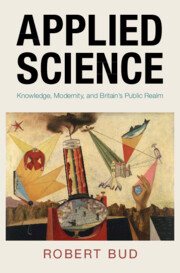Book contents
- Applied Science
- Science in History
- Applied Science
- Copyright page
- Dedication
- Contents
- Figures
- Acknowledgements
- Introduction
- Stage 1 Origins and Pedagogy in the Nineteenth Century
- Stage 2 Research in the Early Twentieth Century
- Stage 3 After World War Two
- 7 Co-existence through Growth
- 8 From Applied Science to Technological Innovation
- Conclusion
- Archives Used
- References
- Index
8 - From Applied Science to Technological Innovation
from Stage 3 - After World War Two
Published online by Cambridge University Press: 15 March 2024
- Applied Science
- Science in History
- Applied Science
- Copyright page
- Dedication
- Contents
- Figures
- Acknowledgements
- Introduction
- Stage 1 Origins and Pedagogy in the Nineteenth Century
- Stage 2 Research in the Early Twentieth Century
- Stage 3 After World War Two
- 7 Co-existence through Growth
- 8 From Applied Science to Technological Innovation
- Conclusion
- Archives Used
- References
- Index
Summary
This chapter asks what processes erased applied science from public view from the late 1960s. It explores the public talk of a second industrial revolution in the 1950s, and the increasing popularity of ‘technology’, gaining the support of the Labour Party, which founded the Ministry of Technology in 1964. Meanwhile, funds for scientific research became tighter, and the public popularity of science waned. Increasingly, as economists became interested in ‘innovation’, analysts questioned the efficacy of the applied science route to wealth. By the end of the 1960s, science-push was giving way to demand-pull as a government-favoured model of innovation. Scientific research was seen as just one of several important inputs into successful development. As a result, the use of the term ‘applied science’ fell precipitously. However, in the twenty-first century, the new concept of ‘translational research’ emerged in the ever-more prominent biosciences to fill the gap between bench and bedside.
Keywords
- Type
- Chapter
- Information
- Applied ScienceKnowledge, Modernity, and Britain's Public Realm, pp. 226 - 254Publisher: Cambridge University PressPrint publication year: 2024

